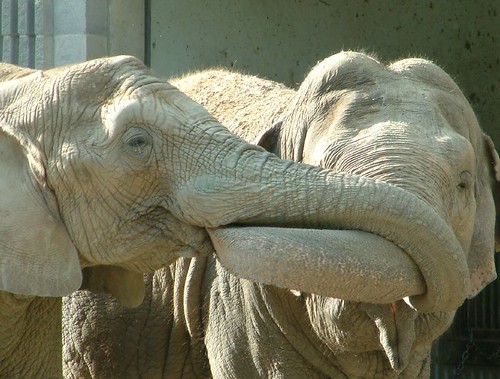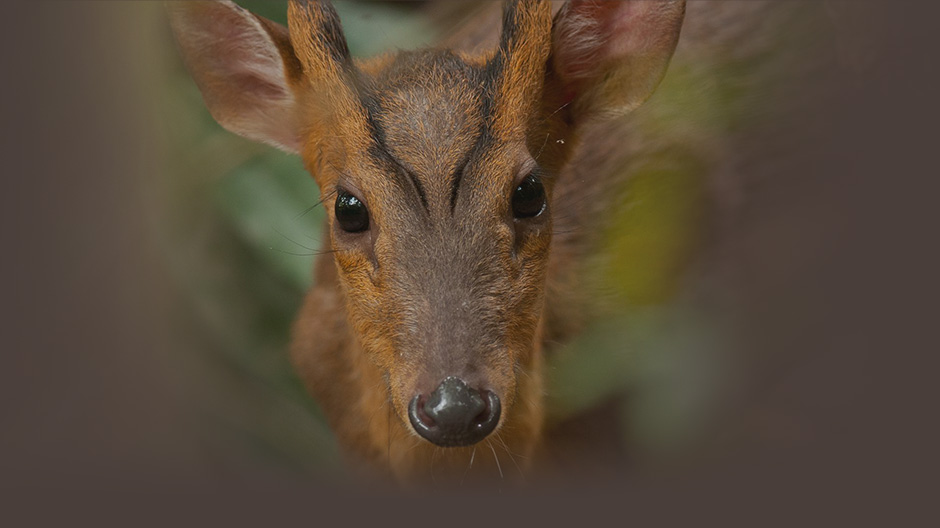動物界的安慰行為並不常見,過去僅在人科、犬科和部分鴉屬鳥類身上觀察到。不過新研究發現,亞洲象會以聲音和肢體觸碰去安慰沮喪的同伴,首次證明大象之間也有安慰行為。
這項新研究以泰國北部26隻圈養的亞洲象為觀察對象。這些亞洲象生活在約30畝大小的營地中,有大象出現沮喪的表現時,研究者便觀察並記錄下附近其他大象的反應,為時1年。
沮喪感受的到 象鼻碰觸就是擁抱
「當大象受到驚嚇,耳朵會外擴、尾巴直豎或捲曲,可能會發出低頻鳴叫或咆哮來表達自己的沮喪情緒。」研究主要作者、曼谷瑪希隆大學的保育生物學講師說。
大象初期的壓力反應多半來自附近的狗經過、蛇或其他威脅性動物在草叢中發出的聲響,或是不友善的大象。研究發現,這時附近的大象會走到沮喪的個體旁,以象鼻輕輕觸碰他的臉,或把象鼻放進對方口中。
大象把鼻子放進其他大象口中的動作,就像大象間的握手或擁抱。「這是個很危險的動作,因為很可能被咬到。這個動作就像在表達『我是來幫你的,不會傷害你』的訊息。」Plotnik說。
情緒感染、同理心、自我意識俱全
「壓力事件後,大象常發出高頻鳴叫聲。我從沒在大象落單時聽過這種聲音。這種聲音可能在表達『噓,沒事啦』之類的意思,類似成人安慰小嬰兒的語氣。」Plotnik說。
當群體中有大象出現沮喪的反應時,一旁的大象常常也會表現出和沮喪個體相似的肢體或情緒,這個現象叫做「情緒感染」,很有可能和同理心有關。
這時若是一群大象聚在一起,牠們便很可能彼此靠近或以肢體互相接觸。「考量大象之間強烈的社會連結性,不難想像大象間會互相關懷。」共同作者、埃默里大學耶基斯國家靈長類動物研究中心心理學教授Frans de Waal說。
過去Plotnik和Frans de Waal就曾觀察到大象能認得鏡中的自己,這是一種測試自我意識的方法,只有少數猿類、海豚和鵲有此能力。
Asian elephants reassure other elephants in distress with physical touches and vocalizations, finds a study that provides the first evidence of consolation in elephants.
Consolation behavior is rare in the animal kingdom, with empirical evidence previously provided only for the great apes, canines and certain birds in the crow family.
The current study focused on a group of 26 captive Asian elephants living on about 30 acres at an elephant camp in northern Thailand. For nearly a year, the researchers observed and recorded incidences when an elephant displayed a stress reaction and the responses from other nearby elephants.
The initial stress responses came from stimuli such as a dog walking past, a snake or other potentially dangerous animal rustling the grass, or the presence of another, unfriendly elephant.
“When an elephant gets spooked, its ears go out, its tail stands erect or curls out, and it may emit a low-frequency rumble, trumpet and roar to signal its distress,” explained lead author Joshua Plotnik, a lecturer in conservation biology at Mahidol University in Bangkok.
The study found that a nearby elephant would go to the side of the distressed animal and use its trunk to gently touch its face, or put its trunk in the other animal’s mouth.
The gesture of putting their trunks in each other’s mouths is almost like an elephant handshake or hug, Plotnik said. “It’s a very vulnerable position to put yourself in, because you could get bitten. It may be sending a signal of, ‘I’m here to help you, not hurt you.’”
The responding elephants also showed a tendency to vocalize.
“The vocalization I heard most often following a distress event was a high, chirping sound,” Plotnik said. “I’ve never heard that vocalization when elephants are alone. It may be a signal like, ‘Shshhh, it’s okay,’ the sort of sounds a human adult might make to reassure a baby.”
Elephants frequently responded to the distress signals of other elephants by adopting a similar body or emotional state, a phenomenon known as “emotional contagion,” which may be related to empathy.
Groups of nearby elephants also were more likely to bunch together, or make physical contact with each other.
“With their strong social bonds, it’s not surprising that elephants show concern for others,” said co-author Frans de Waal, an Emory professor of psychology at Emory’s Yerkes National Primate Research Center.
Plotnik and de Waal provided evidence that elephants can recognize themselves in a mirror, a test of self-awareness passed only by some apes, dolphins and magpies.
※ 全文及圖片詳見:ENS
 網站捷徑
網站捷徑




